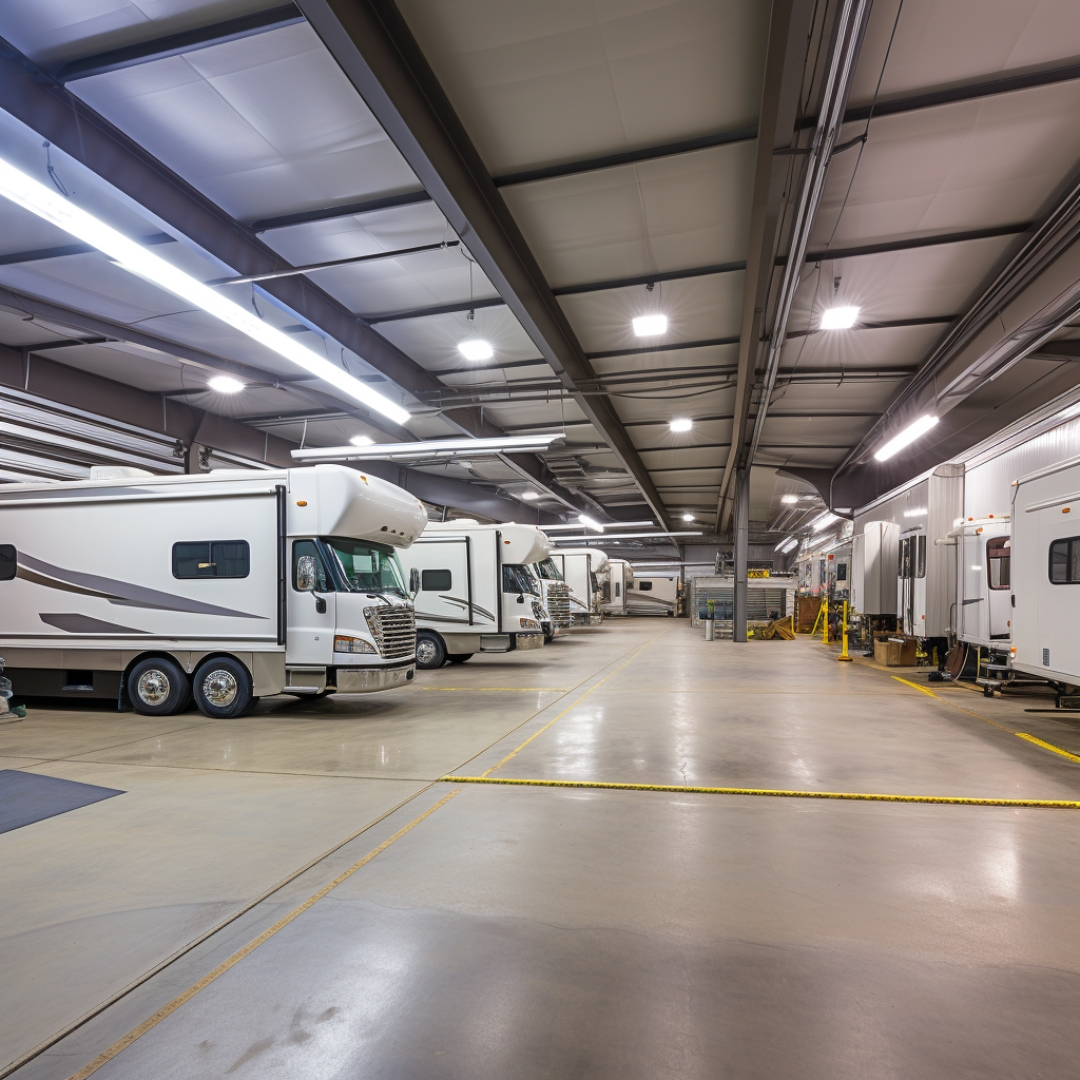
Are you planning to invest in an RV storage facility, but unsure of what it takes to succeed in this rapidly growing market? Worry not! Dive into this comprehensive guide and unlock the secrets to successful RV storage facilities, where we’ll explore market trends, facility design, amenities, marketing strategies, financial considerations, and legal compliance. Let’s embark on this exciting journey and discover the potential that lies ahead!

The RV storage facility market is booming, fueled by a surge in RV ownership and a growing need for storage solutions. As more people invest in recreational vehicles, demand for RV and boat storage facilities, including RV facility options and storage units, is on the rise.
But what drives this burgeoning market, and what opportunities does it present?
The demand for RV storage facilities has skyrocketed in recent years, driven by several factors. First, RV ownership in the United States has reached a record high of 11.2 million households, a staggering 62% increase from 2001. This growth in RV ownership has led to an increased demand for RV storage facilities, in addition to traditional self-storage options.
Second, many homeowners face limited storage options for their recreational vehicles, especially in residential areas with strict parking regulations. As a result, RV owners are increasingly turning to storage facilities to accommodate their vehicles. With these factors in play, the demand for RV storage facilities is only expected to rise, presenting lucrative business opportunities for savvy investors.
Potential market opportunities to leverage the growing demand for RV storage encompass transforming unused land at an existing storage facility into RV parking, or alternatively, acquiring new land and constructing a facility from the ground up. This can be a great addition to a typical self-storage facility, as it caters to a different market segment.
The success of your RV storage facility heavily relies on the selection of an appropriate location. Optimal locations include areas near:
By identifying and addressing the needs of local RV and boat owners, you can tap into a thriving market and expand your boat storage business.

Designing an efficient RV storage facility involves more than just providing space for vehicles. You must carefully consider aspects such as space utilization, layout, and security measures to meet customer needs and expectations. An efficient facility not only maximizes profits but also fosters customer satisfaction and loyalty.
For optimal space utilization and layout in your RV storage facility, it’s important to accommodate various RV sizes and types, with a priority on easy access, smooth traffic flow, and maintaining unit density. Implement strategies such as efficient aisle orientation, clear entrance and exit points, and adequate space between RVs to facilitate easy navigation and parking.
In addition, consider the standard size requirements for different RV types in a storage facility. Typical storage space for RVs can be as wide as 10 feet and as long as 35 feet, providing up to 350 square feet of parking space. Design your facility to cater to these varying dimensions, ensuring that your customers have sufficient space to store their vehicles comfortably.
Customers prioritize security when selecting an RV storage facility. Attracting and retaining tenants, as well as setting your facility apart from competitors, can be achieved by incorporating robust security measures. Some key security measures to consider include:
By implementing these security measures, you can bolster security and put your customers at ease.
In addition to these measures, consider offering enhanced security features such as 24/7 video monitoring, individual unit alarms, and well-lit areas to further ensure the safety of your customers’ valuable recreational vehicles. These security measures not only protect your customers’ investments but also contribute to a positive reputation for your facility.

To differentiate your business in the competitive RV storage market, offering amenities and services that meet your customers’ needs is vital. Essential amenities like electricity hookups, dump stations, and water-filling stations can help differentiate your facility from competitors, while value-added services like wash bays and maintenance services can enhance customer satisfaction and loyalty.
Essential amenities cater to the basic needs of RV owners and can set your facility apart from competitors. Providing electricity hookups, for example, allows customers to power their appliances, lighting, and other electrical devices inside the RV. Similarly, water-filling stations enable RV owners to fill their freshwater tanks, ensuring access to clean water for drinking, cooking, and other daily activities.
Other essential amenities include dump stations, which help maintain hygienic conditions inside the RV and protect water quality, and waste disposal services for proper waste management. By offering these amenities, you cater to the needs of your customers and provide a convenient, one-stop solution for their RV storage requirements.
Offering value-added services can significantly enhance customer satisfaction and loyalty, potentially leading to an increase in rental rates and occupancy levels. Services such as vehicle wash bays and maintenance services provide added convenience for customers, making your facility more attractive and increasing the likelihood of repeat business.
Additionally, consider offering the following value-added services to further streamline the customer experience at your RV storage facility:
By providing these services that cater to the unique needs of your customers, you can cultivate a loyal customer base and ensure the long-term success of your RV storage facility.
An effective marketing strategy for your RV storage facility should encompass building a robust online presence, optimizing SEO, and forging local partnerships and referral networks. By employing these strategies, you can attract a wider audience, increase occupancy levels, and maximize your facility’s revenue potential.
A strong online presence and effective SEO are crucial for attracting customers searching for RV storage options. By targeting relevant keywords such as “indoor RV storage near me,” “covered RV storage near me,” and “self-storage facility,” you can improve your website’s visibility in search results and drive more customers to your facility.
Additionally, to attract potential customers searching for RV storage solutions, you should:
These efforts will help you build a robust online presence and attract potential customers searching for RV storage solutions.
Forming local partnerships and referral networks can also help boost your RV storage facility’s visibility and reputation within the community. Collaborate with local businesses, RV dealerships, and community organizations to generate referrals and increase awareness about your facility.
Successful local partnerships may include:
By establishing strong local connections, your RV storage facility can become an integral part of the community and enjoy continued success, just like an existing self storage facility.
A thorough understanding of the financial aspects involved in operating an RV storage facility is key to maximizing its profitability. This includes:
By carefully analyzing these financial considerations, you can make informed decisions and ensure the long-term success of your RV storage business.
Startup costs and financing options for an RV storage facility can vary depending on the size and type of facility, with funding sources including personal savings, bank loans, and investors. The average startup cost for an RV storage facility is estimated to be around $19,815. It’s essential to develop a detailed business plan and financial projections to secure financing and determine the feasibility of your venture.
Personal savings can be leveraged to commence an RV storage facility by supplying the initial capital necessary for procuring or leasing an appropriate area for vehicle storage. This may entail locating a spot with generous open space for parking RVs and straightforward access from the road. Personal savings can also be utilized for any essential renovations or improvements to the storage facility, such as installing safety measures or forming designated parking spots.
Revenue streams and profit margins for RV storage facilities depend on factors such as rental rates, occupancy levels, and additional services offered. Typical rental rates can range from as low as $84 per month to as high as $400 per month, with prices varying depending on the location and type of storage. The average occupancy rate for RV storage facilities is usually between 70% and 90%, with well-managed facilities reaching occupancy rates higher than 90%.
Additional services, such as retail sales, unit upgrades, or rental equipment, can provide supplementary revenue sources for your facility. Market research and feasibility studies are essential for formulating accurate revenue streams and profit margins, offering insight into the local market and enabling the identification of potential opportunities and risks.
Successfully running an RV storage facility requires adept navigation of the legal and regulatory landscape. This includes adhering to zoning and permitting requirements, as well as environmental regulations.
By ensuring compliance with these legal guidelines, you can avoid potential pitfalls and maintain a strong reputation for your business.
The process of zoning and permitting can be intricate and time-intensive, presenting potential challenges such as rezoning land, acquiring conditional permits, and addressing concerns from the community. RV storage facilities typically fall under commercial (C) or industrial (I) zoning designations, and it’s crucial to review local zoning regulations to determine the specific requirements and restrictions for your facility.
Collaborating with an engineering firm can assist in the development of:
Additionally, be prepared to address potential concerns from neighborhood associations, which may impose constraints on new constructions or require specific designs to prevent an “eyesore” in the vicinity.

Environmental regulations can influence the design, construction, and operations of a facility, necessitating meticulous planning and strict adherence to guidelines at local, state, and federal levels. Ensuring compliance with environmental regulations helps protect the surrounding environment and maintain the safety of your customers’ valuable recreational vehicles.
Failure to comply with environmental regulations can result in hefty fines and potential imprisonment. By adhering to these guidelines, you can avoid legal ramifications and ensure that your RV storage facility operates in an environmentally responsible manner.
In conclusion, launching a successful RV storage facility requires a deep understanding of market trends, facility design, amenities, marketing strategies, financial considerations, and legal compliance. By following the insights shared in this guide, you can unlock the secrets to running a thriving RV storage business and capitalize on the growing demand for these specialized storage solutions. So, are you ready to embark on this exciting journey and tap into the potential of the RV storage market?
To store your RV long term, remember to clean the interior and exterior, take out the batteries, cover it properly, add fuel stabilizer to the gas tank, and store it in a storage facility.
RV storage in Texas typically costs between $100 and $300 a month, with outdoor uncovered parking spots being the most affordable option at around $50.
On average, RV storage in California is $542.24 per month. Find the best discounts on Sparefoot.com for a cost-effective solution.
Storing your RV outside can lead to mold, leaks, sun damage, and a lot of extra maintenance. Keeping it indoors is the best way to ensure its longevity and save on upkeep costs.
Owning a storage facility can be highly profitable, with annual incomes ranging from $365,000 to $800,000 and profit margins up to 41%. Operating expenses per square footage are typically around $3.